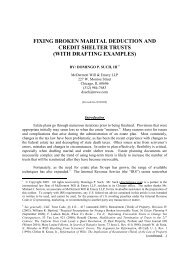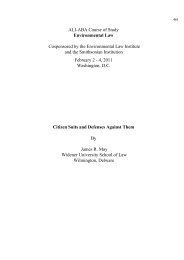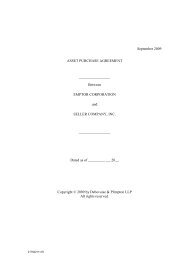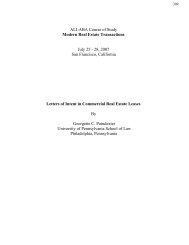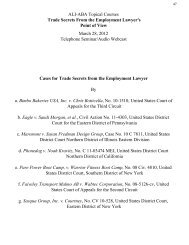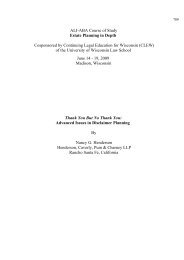How To Write Letters Nonlawyers Will Read (with Sample ... - ALI CLE
How To Write Letters Nonlawyers Will Read (with Sample ... - ALI CLE
How To Write Letters Nonlawyers Will Read (with Sample ... - ALI CLE
Create successful ePaper yourself
Turn your PDF publications into a flip-book with our unique Google optimized e-Paper software.
<strong>How</strong> <strong>To</strong> <strong>Write</strong> <strong>Letters</strong> <strong>Nonlawyers</strong> <strong>Will</strong> <strong>Read</strong> (<strong>with</strong> <strong>Sample</strong> <strong>Letters</strong>)By James W. MartinJames W. Martin is a sole practitioner in St. Petersburg, Florida. This paper is based on a paper theauthor presented at the Florida Bar Convention seminar Effective and Ethical: Keys <strong>To</strong> BetterWriting, sponsored by the Florida Bar Journal and News Editorial BoardWHY DO PEOPLE hate to get letters from lawyers? The letters carry bad news. They mean seriousbusiness. They're hard to understand. They use strange words. They carry the inherent threat of suit.Why do lawyers send such letters? They mean serious business, and they intend to sue.But must they use those ancient, strange words and be so hard to understand, or can lawyersexpress serious business and imminent suit using words everyone knows?Whether writing a demand letter to a contract breacher, an advice letter to a client, or a coverletter to a court clerk, the letter fails if the person receiving it cannot understand what it says.All of these letters have one thing in common: They are not great literature. They will not beread in a hundred years and analyzed for their wit, charm, or flowery words. With any luck they willbe read just once by a few people, followed quickly by their intended result, whether that becompliance, understanding, or agreement.LAWYERS ARE LETTER FACTORIES • Lawyers write many, many letters. An average for memight be five letters a day. This includes advice letters, cover letters, demand letters, all sorts ofletters. Some days have more, some have less, but five is a fairly conservative average, I would think.Five letters a day for five days a week for 50 weeks a year is 1,250 letters a year. This is my 25thyear in practice, so it is quite conceivable that I have written 31,250 letters so far.Why do lawyers write so many letters? A primary reason lies <strong>with</strong>in the ethics of ourprofession. Florida Bar Rules of Professional Conduct Rule 4-1.4 says:"A lawyer shall keep a client reasonably informed about the status of a matter and promptly comply<strong>with</strong> reasonable requests for information.... A lawyer shall explain a matter to the extent reasonablynecessary to permit the client to make informed decisions regarding the representation."While clients can be kept informed and given explanations orally, lawyers certainly know thevalue of the printed word over the spoken word: It is not as easily forgotten or misunderstood.<strong>Letters</strong> also create a record of advice given, which is useful to both the lawyer and the client. That iswhy letters are the preferred method of keeping clients informed and giving clients explanations.SOME THINGS TO DO BEFORE WRITING • Before you start writing the letter, it makes senseto do some preliminary background work.1. Find a FormFind a similar letter you have sent in the past, or see the Appendix to this article for sampleengagement, cover, demand, contract negotiation, contract advice, and fax letters.2. Review Prior <strong>Letters</strong> to this RecipientIn a busy world, it is easy to forget. Review prior letters to remind yourself where you are inthe work process, what has already been said, and what remains to be said. This will give your letter
direction and purpose.3. Do Not Send a Letter to Another Lawyer's Client <strong>with</strong>out that Lawyer's ConsentBefore sending the letter, find out if the nonlawyer is represented by someone else. Start byasking your client. Florida Bar Rules of Professional Conduct Rule 4-4.2 says:"In representing a client, a lawyer shall not communicate about the subject of the representation <strong>with</strong> aperson the lawyer knows to be represented by another lawyer in the matter, unless the lawyer has theconsent of the other lawyer."4. Outline Your Thoughts in a ChecklistBefore turning on your computer or dictating machine, pull out a yellow pad and jot down themain points for your letter. List what you want the letter to say. <strong>Write</strong> the points in any order; writethem as they come into your mind. You can rearrange them when you write the letter. Right nowyou're just making a checklist for writing the letter.5. Keep the Legal Pad Close at HandWhen you run out of ideas for the checklist, put the pad at the side of your desk. New ideasalways spring forth when writing. Jot these down on the pad as you write the letter; they are easilyforgotten.SIMPLE STUFF THAT WILL MAKE YOU LOOK DUMB IF IT'S WRONG • <strong>Letters</strong> begin<strong>with</strong> boring things like the date and recipient's name and address, but if any of these are missing orwrong, the letter writer will look pretty careless, to say the least. So be careful when starting theletter, and you can even include some extra things that will make the letter even better than the regularletters the recipient receives.6. Date Your LetterDate your letter the day you write it, and send it the same day. Undated letters are difficult toreply to. I usually reply to them by saying, "This is in reply to your undated letter that I received in themail on 24 June 1999."Consider using the international dating convention of day-month-year rather than the U.S.convention of month-day-year. As reported in the 1 June 1999 Wall Street Journal:"The quirky U.S. style of date-writing is giving way to the day-first standard used by most of theworld. ...Both the MLA style guide and the Chicago Manual of Style support the day-first format.'You get rid of the comma that way,' says Joseph Gibaldi, director of book acquisition for the MLAin New York."If you are sending a fax or email, then type the time next to the date. While letters cross in themail in days, faxes and emails cross in the wires in hours and minutes.7. Remind Your Client <strong>To</strong> PreserveAttorney-Client ConfidentialitySometimes clients show your letters to others <strong>with</strong>out realizing they can lose theattorney-client privilege of that communication. Add this phrase at the top of the letter to remind themnot to do this:
CONFIDENTIAL ATTORNEY-CLIENT COMMUNICATION DO NOT COPY ORDISCLOSE TO ANYONE ELSEIf the letter is written during or in anticipation of litigation, the following phrase can be used:CONFIDENTIAL ATTORNEY-CLIENT COMMUNICATION AND WORK PRODUCT DONOT COPY OR DISCLOSE TO ANYONE ELSE8. Be Sure <strong>To</strong> Use the Recipient'sCorrect Legal Name and AddressYour letter may be relied upon for its accuracy, so be accurate. Verification of names can beobtained from the public records, the phone book, or Web sites, such as the Florida Division ofCorporations Web site at http://ccfcorp.dos.state.fl.us/index.html. And when it comes to middleinitials, never rely on your memory or guess at it because most of the time you'll be wrong.9. Indicate the Method of Deliveryif Other than MailIf being faxed, include the fax number and telephone number. If being sent by FedEx, statewhether it is by overnight or second day. If being sent by email, state the email address. This willmake it easy for your staff person to send it to the correct place, and it will document for your filehow it was sent.10. Include a Fax NoticeWhen sending by fax, include a notice in case it is sent to the wrong number. The notice I useat the top of my letterhead when sending a fax appears in Appendix 6. After sending a fax, call therecipient to confirm receipt and write that person's name in the space provided. Never rely on the faxmachine itself to confirm a fax transmission; fax machines do not yet have the credibility of a humanwitness.THE CORPUS OF THE LITTERAE • The body of the letter is why you are writing it. You succeedby leaving the reader <strong>with</strong> full knowledge of why you wrote the letter and what it means. You fail byleaving the reader dumbfound and clueless as to why you sent such a letter. While most letters fallsomewhere in between these two extremes, following these suggestions will keep your letters on thesuccessful end of the scale.11. Identify Your ClientIt is important to let others know who is your client at the earliest opportunity. Thisaccomplishes a great deal. First, it tells the reader that your client has a lawyer. This makes your clienthappy because most clients want the world to know they have a lawyer. Second, it tells the readerthat you are not the reader's lawyer. This makes your malpractice carrier happy because it's one lessperson who's going to sue you claiming they thought you were representing them when, in fact, youwere not.Identifying your client is an ethical concern, as well. Florida Bar Rules of ProfessionalConduct Rule 4-4.3 says:"In dealing on behalf of a client <strong>with</strong> a person who is not represented by counsel, a lawyer shall not
state or imply that the lawyer is disinterested."Therefore, the first time you write someone a letter, the letter should open <strong>with</strong> the followingsentence: "I represent _________." After that, every time you write another letter reconfirm whomyou represent by referring to your client by name and as "my client."12. State the Purpose of the LetterWhy leave the reader guessing? Go ahead and say right up front why you are writing theletter. Here are some opening sentences:• "The purpose of this letter is to. ..."• "This letter is to inform you that. ..."• "My client has instructed me to. ..."• "This is to confirm that. ..."• "This confirms our phone conversation today in which. ..."13. If There Are any Enclosures,List them FirstListing enclosures at the beginning of the letter will make it easier for your staff to assemblethem and for the reader to check to be sure that all were received. This is much easier than having toread an entire, perhaps lengthy, letter to ascertain what are the enclosures.The enclosures should be described <strong>with</strong> specificity so that there is later no question aboutwhat was enclosed. At a minimum, the title and date of each document should be listed. If thedocument was recorded, then the recording information should be included. Whether the document isan original or a copy should also be specified. The following is an example:"Enclosed are the following documents from your closing held on ___/___/1999 in which youpurchased the home at _________, St. Petersburg, Florida, from _________:1. Warranty Deed dated ___/___/1999 and recorded on ___/___/1999 at O.R. Book ____, Page____, _________, County, Florida (original);2. Title Insurance Policy issued on ___/___/1999 by _________ on _________ as policy number_________ (original);3. HUD-1 Settlement Statement dated ___/___/1999 (original)."14. Outline the Letter asSeparately Numbered ParagraphsEach paragraph of the letter should state a separate thought, comment, point, or concept. Noparagraph should be longer than four or five short sentences. If the paragraph is longer, then separateit into subparagraphs. The paragraphs should flow in logical, organized fashion. It is not necessary towrite them all at once; you can write them as you think of them. Try to group related concepts in thesame paragraphs or in adjacent paragraphs. See the Appendix for sample letters.15. Give Each Paragraph aTitle and Underline that TitleThink of this as the headline for a newspaper article. This makes it easy for the reader to scanthe letter and choose how to more fully read and digest its contents. This also makes it easier for youlater when you see the letter in your file and try to remember why you wrote it.




